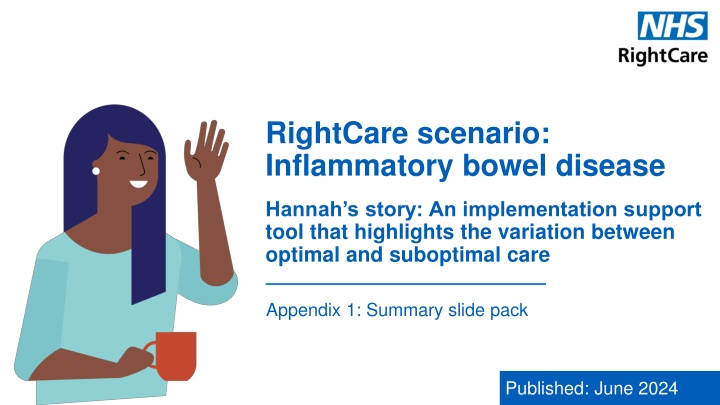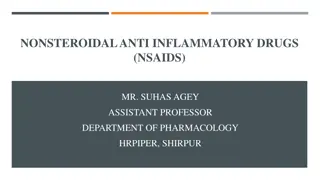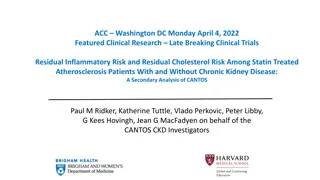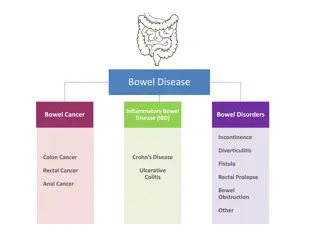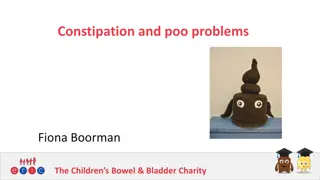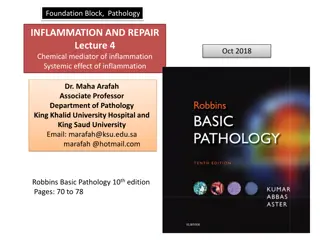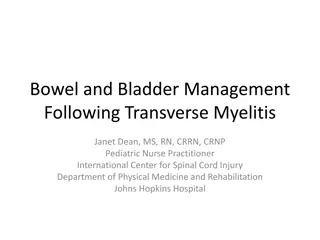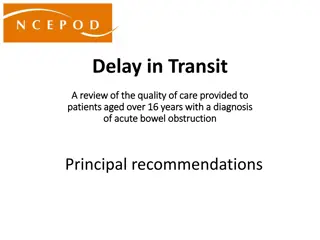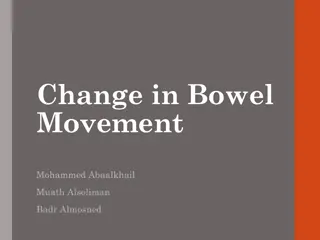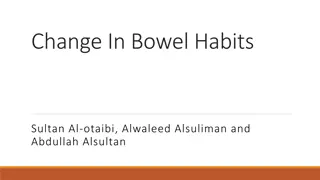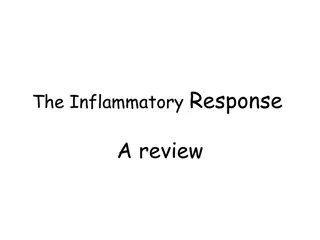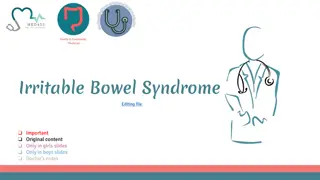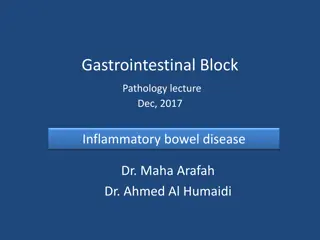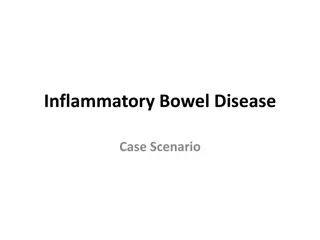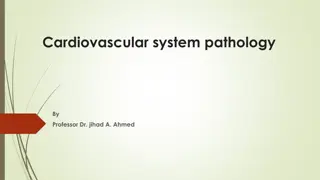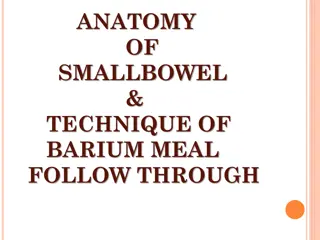Hannah's Struggle with Inflammatory Bowel Disease: A Journey of Challenges and Lessons
Hannah, a vibrant young woman with a bustling social life and active routines, experiences a series of setbacks in her battle with Inflammatory Bowel Disease (IBD). Her journey highlights the importance of timely diagnosis, access to proper care, and comprehensive support services to manage the condition effectively and prevent complications. The narrative underscores the critical need for awareness, education, and holistic care approaches in improving the quality of life for individuals with IBD.
Download Presentation

Please find below an Image/Link to download the presentation.
The content on the website is provided AS IS for your information and personal use only. It may not be sold, licensed, or shared on other websites without obtaining consent from the author.If you encounter any issues during the download, it is possible that the publisher has removed the file from their server.
You are allowed to download the files provided on this website for personal or commercial use, subject to the condition that they are used lawfully. All files are the property of their respective owners.
The content on the website is provided AS IS for your information and personal use only. It may not be sold, licensed, or shared on other websites without obtaining consent from the author.
E N D
Presentation Transcript
RightCare scenario: Inflammatory bowel disease Hannah s story: An implementation support tool that highlights the variation between optimal and suboptimal care Appendix 1: Summary slide pack Published: June 2024
Hannahs story: This is the story of Hannah s experience of inflammatory bowel disease (IBD) and how it could be so much better. Throughout the pathways we have highlighted the key improvement themes that are important in delivering an optimal pathway. In this scenario we examine an IBD pathway, comparing a suboptimal but realistic scenario against an optimal pathway. 2 1 4 3 This document is intended to help commissioners and providers to understand the implications, both in terms of quality of life and cost, of shifting the care pathway. It shows how the RightCare methodology can help clinicians and commissioners to improve the value and outcomes of the care pathway.
Introducing Hannah Hannah is 24 years old and works full time in a busy office. She is confident and friendly with an active social life and several hobbies including travel, reading and cooking which she posts about on social media. Being active and healthy is important to Hannah. She goes to the gym at least three times a week, eats healthily and has always taken her good health as a given. Hannah has been feeling unwell for over a month. She s had diarrhoea during the day and sometimes at night. She urgently needs to go to the toilet 6-8 times a day and sometimes the urge is so sudden that she s nearly had an accident. Eventually she feels that she can no longer ignore her symptoms and makes an appointment with her GP.
Hannah and the suboptimal pathway May, Year 1: Hannah visits her GP with symptoms Hannah sees her GP but is told to come back in a few weeks if there is no improvement. A week later, Hannah experiences severe abdominal pain and diarrhoea and is taken to A&E where she is discharged the same day. Hannah returns to her GP where the discussion focuses on her reducing stress at work. She doesn t feel she is being taken seriously. December, Year 1: Hannah s symptoms continue and she develops an abscess After developing a painful perianal lump where it is treated in A&E, Hannah begins to avoid eating to control her symptoms, misses work and isolates herself. In January, she returns to her GP who refers her to a gastroenterologist and, following a colonoscopy, is told she has Crohn s disease. She is given a course of steroids and 5-aminosalicylic acid (5-ASAs) to be taken for the foreseeable future but is given no information on living with Crohn s disease or the IBD service. She leaves feeling anxious. August, Year 2: Uncontrolled symptoms and lack of support Hannah's symptoms soon return. Her lack of understanding of Crohn s disease has meant she has normalised her situation. She is signed-off from work and sees a new doctor. She tearfully explains how she is fatigued and isn t coping but no referral to mental health or dietetic support is made. There is no signposting to patient organisations and peer support and no care plan is discussed. Hannah continues in a cycle of flares and uncontrolled symptoms and becomes disengaged with health services. She has several emergency care attendances that led to three unplanned emergency admissions to hospital and has two more perianal abscesses. December, Year 3: Hannah has emergency surgery Hannah experiences progressive abdominal pain and is taken to A&E. A CT scan shows an abscess around the terminal ileum, secondary to severe and uncontrolled Crohn s inflammation. She has a resection of a segment of her small intestine and formation of a temporary stoma and is placed on a general surgical ward. After her surgery she isolates herself further and her relationship with her boyfriend breaks down. She struggles with her stoma, is depressed and has not left her house in weeks. May, Year 4: Hannah has a second operation to reverse her ileostomy Hannah has a second operation to reverse her ileostomy. No follow-up endoscopy is arranged after the reversal and in December, she develops abdominal pain and another perianal abscess. She returns to A&E and has an MRI on her small bowel and pelvis and a colonoscopy, which confirms perianal Crohn s and recurrent ileal Crohn s. 12 weeks later she sees the gastroenterologist in clinic who prescribes infliximab and azathioprine. They explain to Hannah she will need to take these for the foreseeable future. Over the next few weeks, Hannah s Crohn s symptoms ease and she returns to work. Hannah is pleased her Crohn s is under control but is confused and angry as to why it s taken this long to start the right treatment.
Hannah and the optimal pathway May, Year 1: Hannah visits her GP to discuss symptoms The GP probes more into Hannah's symptoms and causes of stress. They use the Advice & Guidance e-Referral Service (e-RS) system to seek specialist advice. They order appropriate tests including a faecal calprotectin test (FCP), a full blood count, urea and electrolytes, and C-reactive protein. They explain what each test means and signposts Hannah to further information. June, Year 1: Hannah receives a timely diagnosis and supportive information Hannah sFCP test result falls into the high risk category for IBD. She is referred for a colonoscopy and biopsy to confirm the IBD diagnosis. Hannah attends her colonoscopy appointment, where she is told that she may have Crohn s disease. She is signposted to further information and arranges an urgent out-patient consultation where Crohn s disease is confirmed. She is referred to an IBD nurse specialist and assigned a named consultant gastroenterologist. The IBD nurse specialist carries out a full assessment and Hannah s mental health is discussed. A personalised care and support plan is written, and Hannah receives a patient pack and is referred to a dietitian. September, Year 1: Hannah learns to come to terms with her diagnosis and receives personalised care Hannah is reviewed back in a consultant clinic where her medications are reviewed and discussed with her. Hannah and the IBD nurse specialist agree on an ongoing management plan that includes a patient-initiated follow-up (PIFU) pathway, supporting her to navigate and access specialist advice and treatment quickly, aiming to reduce the impact of flares. Although the diagnosis is a shock, Hannah feels confident in knowing her IBD nurse specialist is on hand to answer any questions. May, Year 2: Hannah accesses specialist advice to manage complications Hannah develops a perianal abscess. Following her PIFU pathway she calls her IBD nurse specialist who refers her to the on-call surgical team using the local abscess pathway. It is investigated and treated in a timely manner, and she is given discharge information that is clearly explained. Hannah has annual reviews with her IBD nurse specialist and gastroenterologist. Hannah knows what to do if she has a flare and her personal relationships and work remain unaffected. February, Year 5: Hannah undergoes elective bowel surgery Hannah has been fully engaged with her treatment and has stayed well with no time off work. However, she is no longer responsive to treatment and bowel surgery is required. Due to all the information and support she has received she knows what to expect and is prepared. Following the operation, she stays on a specialist ward where her mental health, nutrition and pain are assessed. On discharge a joint surgical and medical follow-up appointment is made and in March the following year, she undergoes elective surgery to reverse her stoma. While it s been challenging, Hannah has felt supported throughout and is confident in managing her Crohn s.
Key themes of optimal care Information point 1: Monitoring the effectiveness of treatment and shared care Information point 2: Timely identification and referral Information point 3: Importance of personalised care and self-management Information point 4: Rapid access to specialist advice and treatment Information point 5: Effective multidisciplinary working Information point 6: Addressing delays to surgery and driving up quality Inappropriate steroid prescribing can result in dependence and side effects and can be an indicator of poor- quality care. People with suspected IBD should have a specialist assessment within four weeks of referral. Delayed diagnosis is linked to multiple primary care and A&E attendance(s), higher incidence of surgery and complications, reduced response to medication and more expensive treatments. Inability to self-manage is associated with complications, poorer mental and physical health. Flare-ups require rapid active management to minimise the impact of relapse on physical wellbeing and social functioning. Every patient should have a flare plan. Multidisciplinary working is associated with higher quality care. The IBD service should be resourced to meet the staffing requirements defined by the IBD Standards and NICE Quality Standard. People having surgery for inflammatory bowel disease have it undertaken by a colorectal surgeon who is a core member of the inflammatory bowel disease multidisciplinary team. Every patient should have a personalised care and support plan which is regularly reviewed. Structured self-management programmes should be commissioned. Services should routinely collect and audit data including on patients receiving excessive steroids each year and have protocols in place for communicating and recording steroid use between primary and secondary care. Shared care protocols should also be in place for immunosuppressants. Rapid access clinics, advice lines and prompt access to investigations should be in place in every service, supported by flare pathways that are agreed between primary, secondary and emergency care. Pathways should deliver coordinated care and every service should have a leadership team to drive development and involve patients in service development. The expertise and experience of the clinical team will enable the best judgement of when to undertake surgery, and should ensure the quality of clinical care before, during and after surgery. Clear local protocols for faecal calprotectin testing in primary care, as part of agreed referral pathways between primary and secondary care, and emergency and specialist teams should be in place and monitored. Information about the IBD advice line should be shared. IBD Standard Section 4: Flare management self management, IBD UK IBD Standard Section 7: Ongoing care and monitoring, IBD UK NICE Quality Standard (QS81): Statement 2: Multidisciplinary team support NICE Quality Standard (QS81), Statement 3: Surgery NICE Quality Standard (QS81): Statement 4: Monitoring drug treatment IBD Standard Section 1: The IBD Service, IBD UK IBD standard Section 4: Flare management - steroid management, IBD UK NICE Quality Standard (QS81): Statement 1: Specialist assessment IBD Standard Section 2: Pre- diagnosis IBD Standard Section 7: Ongoing care and monitoring - shared care, IBD UK IBD Standard Section 3: Newly diagnosed, IBD UK
The costs of Hannahs journeys As the below table shows, the optimal journey is cheaper than the suboptimal, but the main difference is the quality of care and improved outcomes for Hannah, and the reduced burden on the wider NHS through fewer A&E attendances. Sector Primary care Secondary care Medicines Total Optimal ( ) 31 9,198 10,267 19,496 Suboptimal ( ) 126 20,488 1,386 22,000 National average costs and similar data sources have been used to calculate the indicative healthcare costs of two hypothetical pathways of care for an individual fictionalised typical person, and therefore do not represent the local cost of service provision. It is recommended that systems work with local clinical leaders and costing colleagues to map existing pathways, taking into account local circumstances and evidence, and reflecting the make-up of the local population and services already in place.
Areas for systems to consider Below are some of the questions featured in the scenario. They are to support discussion and investigation within local systems and are focused on the key optimal themes that can lead to improvement in healthcare for people with IBD: Are there clear referral and emergency pathways and protocols in place between primary and secondary care for the investigation of persistent lower gastroenterological symptoms in both children and adults including the appropriate use of faecal calprotectin testing? 1 Are there clear local pathways and protocols in place between primary, secondary and emergency care for the management of IBD including shared care protocols for immunosuppressants, in particular when patients are experiencing flares, thus making the most of every contact and reducing inappropriate attendances to A&E and admissions? 2 Does your local IBD service meet the IBD Standards 2019 defined multidisciplinary team level of staffing to support every aspect of IBD care from diagnosis and initial treatment, to rapid access to specialist review and support, and surgery and ongoing care? 3 Are regular structured self-management learning and education opportunities for children and adults with IBD provided locally? 4 Are information materials available in a range of formats and languages to suit individual needs and preferences, with patient feedback audited to identify and address any gaps in provision? 5 Are patients routinely provided with their written personalised care plans to support self-management, which include their diagnosis and current treatment, who to contact for advice and support, what to do in the event of a flare and cancer surveillance colonoscopy due dates? 6 Does your local IBD service have mechanisms in place to conduct routine reviews and monitoring with options for patients, including face-to- face IBD nurse and dietetic specialist clinics and expert pharmacist clinics, IBD advice lines and virtual clinics? 7
Further information For more information about Hannah s journey or RightCare: rightcare@nhs.net www.england.nhs.uk/rightcare www.future.nhs.uk/NationalRightCare Click here for the full scenario
